The Canon de 155 C Mle 1917 was built by the French firm of Schneider and officially referred to as the C17S where the C stood for Court or short in English. It was basically a Canon de 155 C Mle 1915 Schneider but with the breech changed from using metal cartridges to bagged charges in order to make operating the gun less costly. The earlier gun was based on the 152 mm M1910 howitzer developed for the Russian Army by Schneider which used the carriage and recoil system that was later used by the Canon de 105 L Mle 1913 (L13S). Modifying the carriage to mount a 155 mm howitzer for the French Army was relatively straightforward.
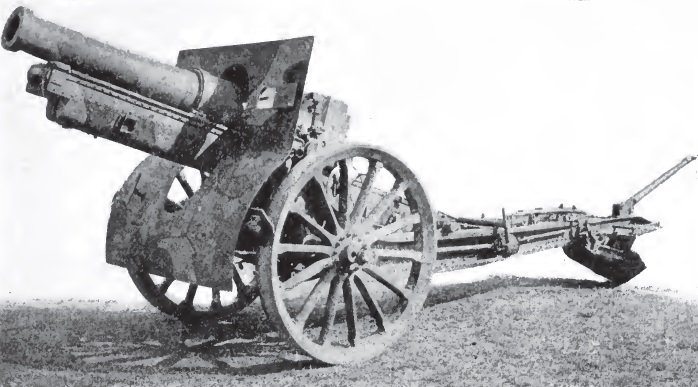
Carriage
The C17S carriage was similar in concept to that of the L13S. It consisted of a box trail with side arms in the front half that allowed space for the gun to recoil at higher elevation angles. A curved shield was mounted on the front of the trail to protect the gun crew with a hinged opening to allow for forward observation of the gun sights. The rear of the trail was provided with a spade to stabilise the gun during firing which was supplemented by brake shoes acting on the rear of the wooden wheels which were fixed to the end of a steel axle passing through the trail.
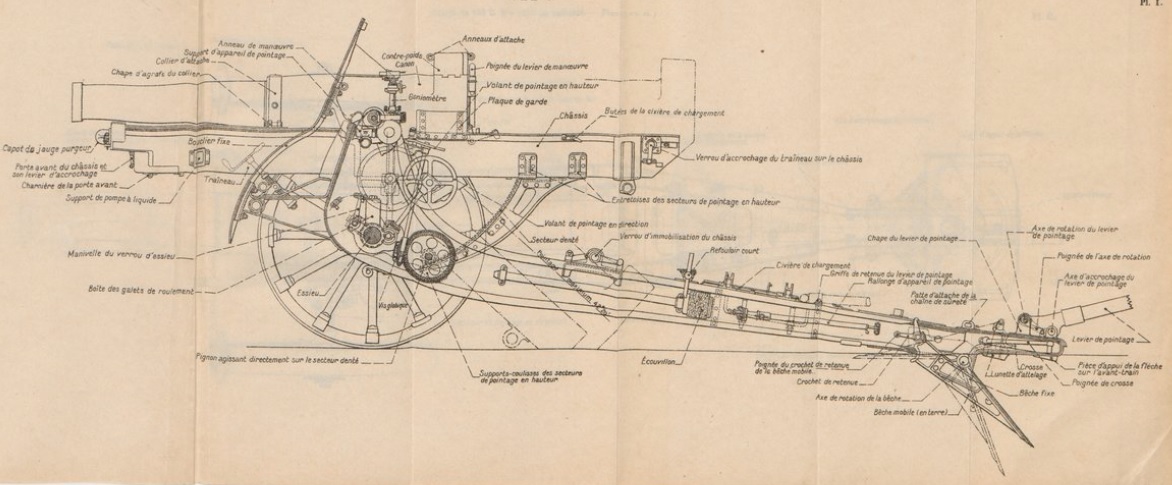
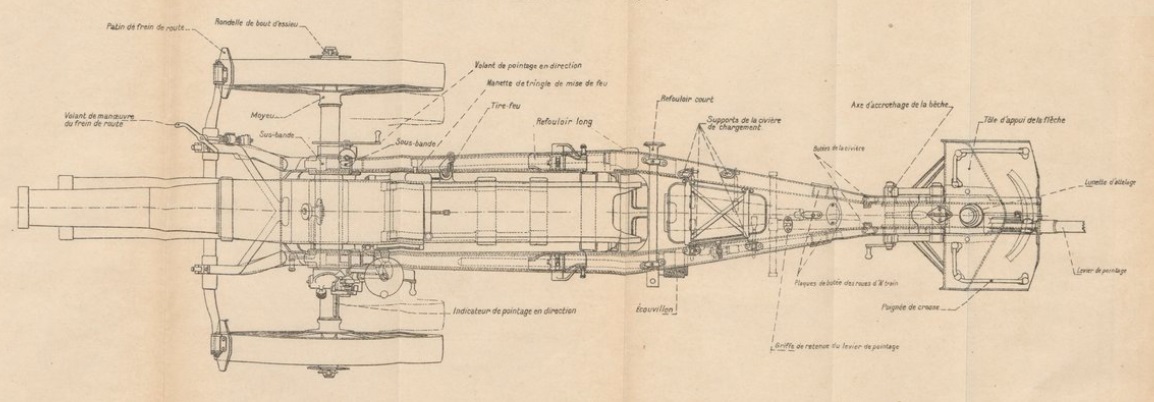
The gun pivoted on trunnions running in bearings at the top of the front of the trail with traverse provided by moving the trail sideways by up to 3 deg either side along the wheel axle. A traversing hand wheel was provided on both sides of the trail for this purpose that each rotated a screw thread inside a tube in front of the axle. This in turn moved a nut on the thread that was attached to the wheel axle resulting in the front of the trail being moved sideways along the axle.
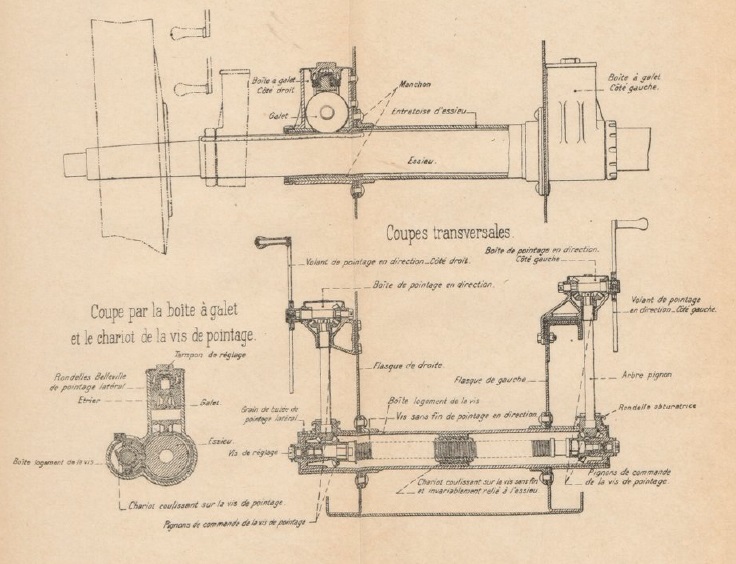
The gun was elevated by means of a pair of large toothed arcs fitted either side under the gun cradle. An elevating hand wheel was provided on the left-hand side of the carriage which rotated a pair of elevating arc pinions via a gear train to provide fine adjustment of the gun’s elevation.
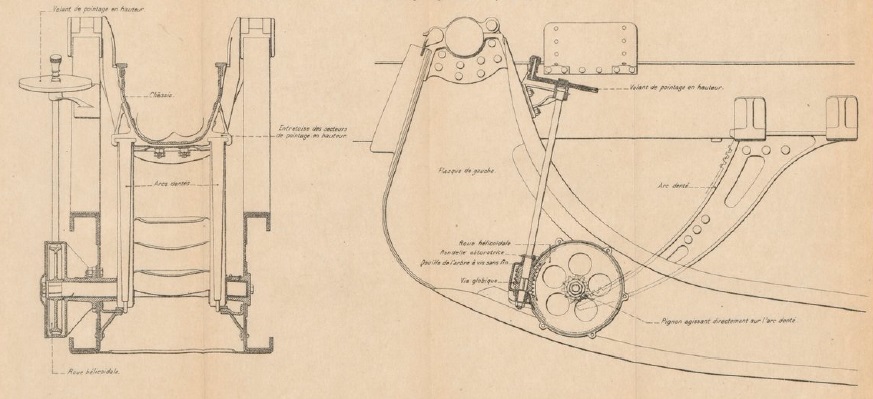
The gun was transported by either 8 horse or via motorised tractor. When horse drawn, the gun was hooked up to a two wheel limber as shown and, to balance the gun between the two sets of wheel, it was locked in the full recoil position.

Gun Design
The C17S gun was 2.332 m or 15 calibres long and was of built-up construction as was normal during the early part of the 20th century. The gun consisted of a rifled tube with a chamber for the projectile at the rear behind which was an interrupted threaded section for the breech. A jacket was shrunk over the rear portion of the tube with fittings to support the single motion breech operated by a lever.

An interrupted screw breech was used with a single motion lever that, when operated, rotated the breech screw to unlock it before swinging it clear of the breech opening. The sealing of the breech (obturation) was achieved by using a mushroom shaped obturator that fitted into the front of the breech block. Between the mushroom head and the front of the breech block was a sealing ring such that, when the breech was closed, the seal was pressed against the tapered rear of the combustion chamber. When a charge was fired, the combustion chamber pressure pushed the obturator slightly backwards further compressing the sealing ring against the side of the chamber completely sealing it.
The C17S used bagged charges which were ignited using a percussion cartridge that fired through a vent in the centre of the obturator. This cartridge was set off by a striker that was hit by a hammer (marteau) at the rear of the breech that was cocked manually and released via a lanyard.

Recoil System
Unlike the German and British field howitzers used in WW1 which used hydro-spring recoil systems, the C17S used a much more sophisticated hydro-pneumatic recoil system. The C17S recoil system was contained within the cradle (berceau) on a recoil sled (traineau) on which the gun was attached which recoiled along runners either side of the cradle. The cradle extended some distance behind the breech to allow the gun to be fully supported for the full length of recoil.
Within the recoil sled, there were two cylinders in the lower part with the right-hand one forming the hydraulic buffer (frein) and the left-hand one forming the recuperator (recuperateur). At the front above these cylinders were 2 reservoirs for the recuperator. The hydraulic buffer is shown at the bottom of the cutaway drawing below which is drawn for clarity with the buffer and the recuperator one above the other rather than side by side.
The hydraulic cylinder was filled with oil and contained a piston on the end of a tube attached to the front of the cradle so that, as the gun recoiled, the cylinder moved backwards while the piston stayed still. The piston contained small ports to restrict the flow of oil past it during recoil and, in so doing, absorbed most of the recoil energy helped a little by the air pressure in the recuperator. The hollow piston tube (tige de frein) was also filled with oil and contained another piston on the end of a rod (contretigre) attached to the rear of the recoil sled. The purpose of this inner hydraulic buffer was to absorb the energy generated by the recuperator in order to bring the gun to a gentle stop when it was returned to battery.
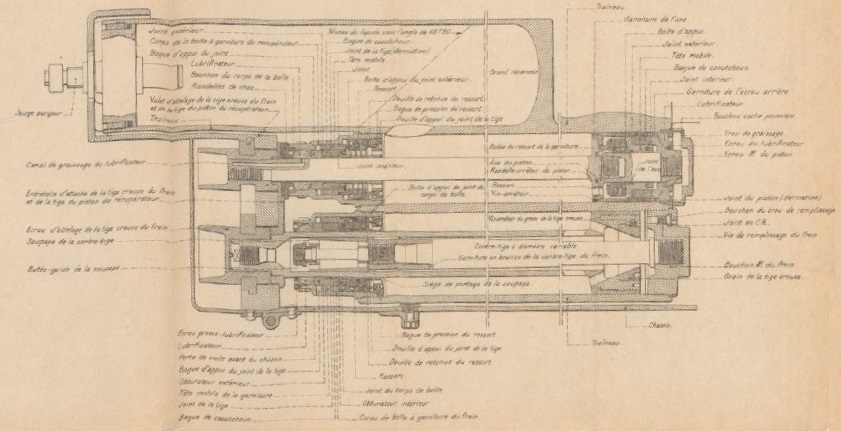
The recuperator is shown just below the large reservoir in the cutaway drawing above and was responsible for returning the gun to battery after the recoil ended. The recuperator consisted of a cylinder in the lower part of the recoil sled, which recoiled with the gun, and a piston on the end of a rod fixed to the front of the cradle. As the cylinder moved backwards, the oil in front of the piston was forced into the two large (grand) reservoirs at the front of the recoil sled thus compressing the air inside. Once the recoil had stopped, this increased air pressure then forced the gun forward back into battery. The ambient air pressure was maintained at 500 psi.
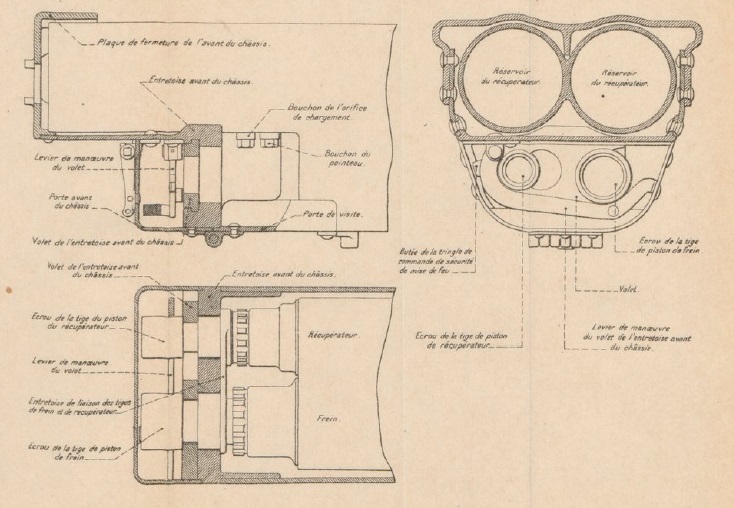
Unlike the equivalent British Ordnance QF 4.5-Inch Howitzer, the L13S did not have to use a cut-off gear to restrict the length of recoil as the gun was elevated as there was always sufficient clearance for the recoiling breech above the ground. The maximum recoil distance of the gun was 1.25 m.
Sighting
The sights were mounted on a bracket fixed to the end of the left-hand gun trunnion and therefore elevated with the gun. As for nearly all howitzers, the sights were reciprocating to allow them to compensate for the carriage wheels not being level, which was the norm. Ignoring the spin drift of the shells, their trajectory normally lies in the vertical plane through the gun barrel. However, if the wheels and therefore the gun trunnions are not horizontal, this trajectory plane will be rotated away from the centre line of the gun cradle in the direction of the lowest wheel resulting in a large sighting error. To eliminate this effect, the sights were mounted on a reciprocating bracket that could be tilted sideways about an axis parallel to the gun to put the sights back into the same vertical plane as the projectiles. This tilting was performed using the knurled knob (bouton molete) and the cross-level bubble (niveau d’inclinaison) at the rear of the sight.
The required tangent elevation was set on the sight using the large knurled knob at the rear of the sight assembly which controlled the height of a toothed arc on which the sights were mounted- when raised, this tipped the sights forward with a tangent elevation scale provided marked in milliemes (the same as a NATO MIL with 6400 to 360 degrees). A clinometer was provided above the elevation adjustment knob consisting of a level bubble (niveau de tir) and a pair of knobs to set the angle of sight from -500 to -500 milliemes . To set the gun to the required quadrant elevation to hit a target at a particular range, the angle of sight and the tangent elevation was set on the sight and then the gun was elevated until the clinometer bubble was level.
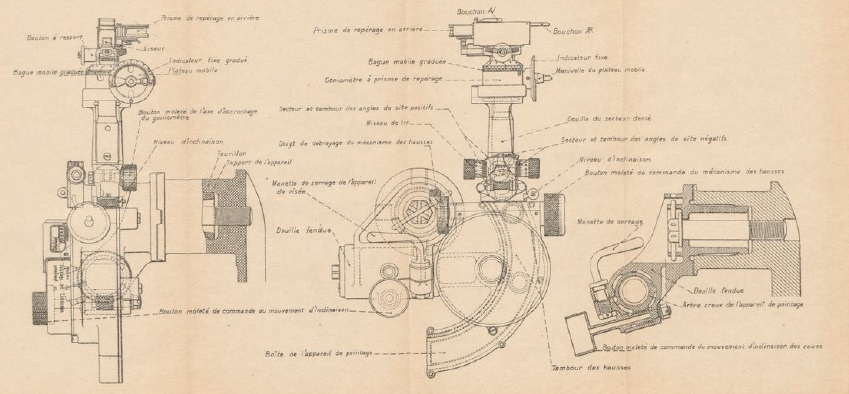
The C17S was mainly used for indirect fire where the target was not visible in the sights. However, the sights used were developed before the adoption of an effective panoramic sighting telescope (goniomètre panoramique) became available and instead used a goniometer (goniomètre) mounting a collimator on top of a rotatable column as the main sighting device. The goniometer was fixed in a socket at the top elevating arc. The collimator sight itself consisted of a rectangular hood through which the target was viewed together with a small collimator in the lower part. The collimator generated a cross-hair reticule in the field of view of the sight effectively focused at infinity. Therefore, when looking through the sight hood, the gun layer saw the target with the reticule superimposed on it with very little parallax. In use, the gun layer positioned his head about 10 inches behind the sight to use it properly.
The mortar was layed for direction using a suitable fixed aiming point that could be viewed in the sight. The offset bearing from the aiming point to the target was set on the collimator sight using the crank handle (manivelle du plateau mobile) and the fine and coarse bearing scales. The inclination of the field of view of the collimator sight could be changed using the tilt knob (molette de l’arbre d’inclinquetage). The aiming point for the sight could be chosen to be in front of the gun, to the side of it or to the rear. To enable an aiming point to be used behind the gun, the collimator sight was provided with a prism (prisme de reperage en arriere) providing a rear view past the sight.
Ammunition
The C17S used bagged charges with 6 different charge levels (00, 0, 1,…5) and muzzle velocities available. The following projectiles were used with the C17S where the bottom two projectiles Shrapnel Shells and teh rest are high explosive.
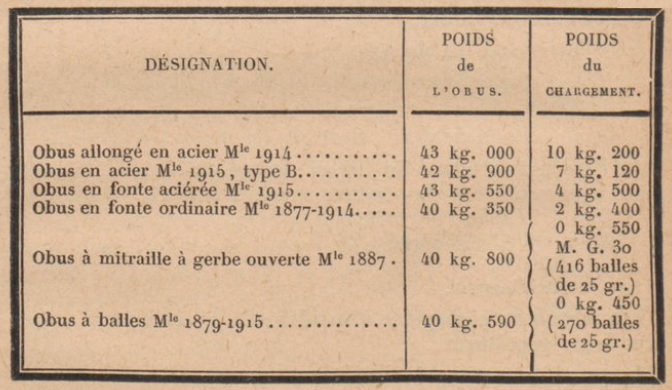
Canon de 155 C Mle 1917 Specifications
- Length: 9.81 m
- Maximum Width: 1.52 m
- Wheels: Wooden 1.33 m in diameter
- Weight of Gun & Carriage: 3300 kg
- Length of Gun: 2.332 m or 15 calibres
- Bore: 15.5 cm
- Muzzle Velocity: 450 m/s
- Maximum Range: 11,200 m
- Trail: Box trail
- Recoil System: Hydro-pneumatic
- Maximum Recoil: 1.30 m
- Rifling: Uniform 1 turn in 25 calibres
- Length of Rifling: 1.737 mm or 11.2 calibres
- Twist: Right-hand
- Grooves: 48
- Firing Method: Percussion
- Elevation: 0° to +42°
- Traverse: -3° left to +3° right
![]()

